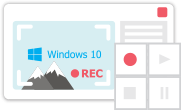Video Editor
Use free video software to create and edit videos of any complexity from a family greeting card to a company presentation. Cut, merge video files, apply visual and audio effects, use filtration and image correction, make slideshows and add an appropriate soundtrack. Use multi-color Chroma Key and advanced parameters settings to give your video a professional look. All popular video and audio formats are supported.
Video Converter
This program is intended for converting video files from one format to another. Nearly all popular video formats are supported (both reading and saving). In addition, the program drastically simplifies the task of converting videos for playback on specific multimedia devices, such as iPhone, Samsung Galaxy or Huawei P30 Pro. The program is extremely easy to use, has a modern interface and all necessary video processing functions.
Audio Converter
The audio converter will help you convert audio files from one format to another. All key audio formats and codecs are supported. The program also allows you to manage playlists and meta tags, extract audio from video files and save these tracks on your computer in any format.
Audio CD Grabber
This audio tool is intended for grabbing audio tracks from compact discs and saving them to the user’s computer in any format. Nearly all popular audio formats and codecs are supported. The program can also extract track details from the FreeDB server for automatic file renaming and updating meta tags.
Video Editor
Video Converter
Audio Converter
Audio CD Grabber

Multifunctionality
A wide array of multimedia processing tools in one free video software suite.

High speed
Our programs use fast
and high-quality algorithms optimized for single and multi-core CPU’s.

Affordability
VSDC video software is freely available for download to Windows OS-based PCs and laptops.
- This holiday season embraces new beginnings with the latest update of VSDC Video...
- Change is all about improvement, and this process wouldn't be possible without y...
- Intro In 2024 the options range for creating visual effects is incredibly dive...
- Are you ready to explore new heights with the latest major VSDC update? Finally,...
Duplicate object
Understanding and applying the Duplicate object
In VSDC video editor, you can easily create multiple copies of an object or several objects at once by using the Duplicate option. To access this feature, simply navigate to the Add Object menu located at the top of the scene area, or find it in the left side toolbar of the scene.
After selecting the Duplicate option, a pop-up window will promptly appear on your screen, providing you with the flexibility to adjust its position settings as per your preference. In this window, you can set the precise time at which the duplicate will appear on the scene, as well as how long it will remain visible before disappearing. Once you have set these parameters, click OK to apply the changes and close the window.
As soon as you select the settings, you'll notice that your cursor transforms into a crosshair, which is a crucial visual cue to help you pinpoint the precise location of the duplicated object on your screen. All you need to do is click on the desired point in the scene and drag it to specify the size and shape of the duplicate object. Once you have done this, you will see an empty object appear in both the preview window and on the timeline. This object serves as a template for your future copy, which you can easily modify and edit as needed.
Duplicate object settings
Similar to other objects in VSDC, the Duplicate object contains two groups of settings in the properties window: Common settings and Duplicate object settings.
The Common settings group provides you with the ability to modify the object's name, position in the timeline, and location in the scene. This can be extremely useful if you want to make adjustments to the settings you initially set when creating the Duplicate object.
The Duplicate object settings provide advanced options for modifying the Duplicate object to meet your specific needs.
Under the Source type option, you can define how your object or objects will be copied. For instance, selecting the Object's image duplicate option will duplicate the object in its original form. This means that any effects, color changes, or size adjustments applied to the original object will not be reflected in the duplicate. To achieve this, simply position the cursor on the part of the object you wish to copy, place the Duplicate object on the layer above, select the first option under the Source type field, and choose the desired file to copy in the Duplicated object field.
On the other hand, if you want to duplicate the object along with all the modifications that you made, including the applied effects, you need to select the second option Object duplicate, in the Source type field. Unlike the first option, this duplicate object can be positioned anywhere on any layer of the timeline, giving you more flexibility and control over its placement and appearance.
The third option in the Source type menu is called Scene Duplicate. As the name suggests, this option duplicates the entire scene that you select in the Duplicated object field. This feature can be incredibly helpful if you have a project with multiple scenes and you want to display a portion of one scene within another.
The Stretch image option indicates whether the image should be stretched to fit the size of the Duplicate object, even if it causes some cropping of the edges due to resolution differences. However, stretching the image may compromise its original aspect ratio and reduce its quality. To avoid this issue, the Pro version of the program provides advanced resizing modes, such as Nearest neighbor interpolation, Cubic Interpolation, Supersampling interpolation, and Lanczos interpolation, to help you improve the quality of your resized images.
The Fill background checkbox determines whether the background should be filled with a color or not. If selected, you can choose the color to fill the background using the Color option.
This software can be downloaded from Free Video Editor description page.

This program allows you to capture the video of your desktop and save it on your PC in various formats. Coupled with a video editor, the program is a great tool for creating presentations, tutorials and demo videos.

The program captures video from external devices and records it to computer in a free format. You can save video from video tuners, webcams, capture cards and other gadgets.

"VSDC Free Video Editor is a surprisingly powerful, if unconventional video editor"
- PC Advisor

"This video editor gives you tons of control and editing power"
- CNet

"The editor handles many common formats and boasts a good deal of capabilities when it comes time to alter lighting, splice video, and apply filters and transitions in post production"
- Digital Trends